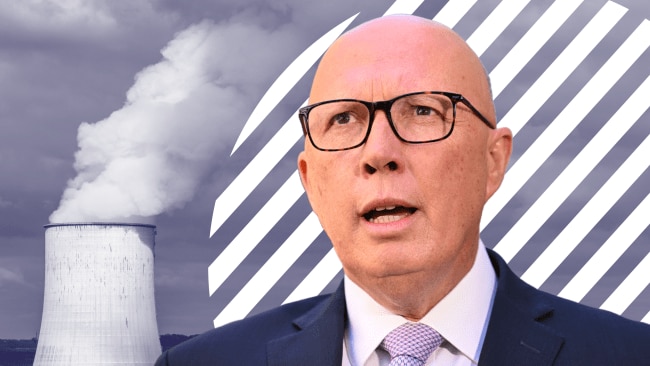The Coalition has pledged to establish a nuclear regulatory agency within the first term of government, with the first nuclear reactors expected to come online in 2035.
The Coalition has pledged to establish a nuclear regulatory agency within the first term of government, with the first nuclear reactors expected to come online in 2035.
Opposition Leader Peter Dutton’s push for nuclear comes amid growing concerns over the nation’s energy future, particularly the transition to cleaner, renewable energy.
The plan to introduce nuclear energy has received mixed responses, with proponents highlighting its potential to provide reliable, low-emission power.

The Coalition has pledged to establish a nuclear regulatory agency within the first term of government, with the first nuclear reactors expected to come online in 2035.
Shadow energy minister Ted O’Brien told Sky News Sunday Agenda that the Coalition would establish a nuclear regulator “certainly within the first term of government”.
“We already have a nuclear technology regulator in Australia, ARPANSA, recognised around the world as best in class,” he said.
The Australian Radiation Protection and Nuclear Safety Agency was founded in 1999 to “protect” citizens from ionising and non-ionising radiation.
According to Mr O’Brien, expanding ARPANSA’s role to oversee nuclear power plants would be a “short exercise” and could be completed within a few years.
“We’ve already got a very sound regulatory body that needs to be expanded, no doubt, to licence and monitor nuclear energy power plants,” he said.
“But the best in the world are looking at Australia, saying, ‘You’re already a nuclear nation, you have what it takes, you can decarbonise with nuclear at speed’.”
The House of Representatives’ interim report for the inquiry into nuclear power generation recently heard that ARPANSA was “well positioned” to regulate nuclear energy.
Multiple nuclear experts said that ARPANSA could develop on its existing regulatory guidance to develop a clearer national position.
Following the establishment of a nuclear body, Mr O’Brien said the first small modular reactors could be producing electrons by 2035.
He added that the full deployment of nuclear power would take place throughout the mid- to late-2030s, with the aim of reaching 14 gigawatts of nuclear capacity by 2050.
The Coalition has pledged to establish a nuclear regulatory agency within the first term of government, with the first nuclear reactors expected to come online in 2035.
Opposition Leader Peter Dutton’s push for nuclear comes amid growing concerns over the nation’s energy future, particularly the transition to cleaner, renewable energy.
The plan to introduce nuclear energy has received mixed responses, with proponents highlighting its potential to provide reliable, low-emission power.

The Coalition has pledged to establish a nuclear regulatory agency within the first term of government, with the first nuclear reactors expected to come online in 2035.
Shadow energy minister Ted O’Brien told Sky News Sunday Agenda that the Coalition would establish a nuclear regulator “certainly within the first term of government”.
“We already have a nuclear technology regulator in Australia, ARPANSA, recognised around the world as best in class,” he said.
The Australian Radiation Protection and Nuclear Safety Agency was founded in 1999 to “protect” citizens from ionising and non-ionising radiation.
According to Mr O’Brien, expanding ARPANSA’s role to oversee nuclear power plants would be a “short exercise” and could be completed within a few years.
“We’ve already got a very sound regulatory body that needs to be expanded, no doubt, to licence and monitor nuclear energy power plants,” he said.
“But the best in the world are looking at Australia, saying, ‘You’re already a nuclear nation, you have what it takes, you can decarbonise with nuclear at speed’.”
The House of Representatives’ interim report for the inquiry into nuclear power generation recently heard that ARPANSA was “well positioned” to regulate nuclear energy.
Multiple nuclear experts said that ARPANSA could develop on its existing regulatory guidance to develop a clearer national position.
Following the establishment of a nuclear body, Mr O’Brien said the first small modular reactors could be producing electrons by 2035.
He added that the full deployment of nuclear power would take place throughout the mid- to late-2030s, with the aim of reaching 14 gigawatts of nuclear capacity by 2050.
Mr O’Brien’s comments come as the debate over energy policy intensifies heading into the election.
The Albanese government has continued to push for a greater reliance on renewable energy, arguing that it will be a cleaner and more cost-effective solution.
However, the Coalition’s proposed nuclear energy strategy suggests a long-term commitment to diversifying the energy mix through gas, nuclear and renewables.
Education Minister Jason Clare told Sky News Sunday Agenda the Coalition has not been clear on how it was going to pay for the expensive nuclear reactors.
“It’s the most expensive policy that any opposition or government has ever taken to the Australian people ever. Hundreds of billions of dollars,” he said.
“Australian people have got a right to know not just how much it will cost… What he’s going to cut to pay for it?
“We know that he’ll cut (services) and you’ll pay.”
Source: Sky News


